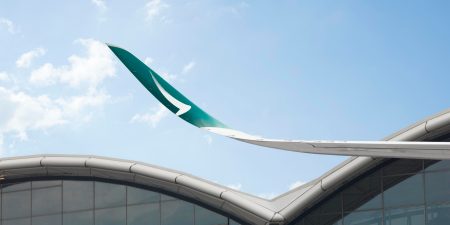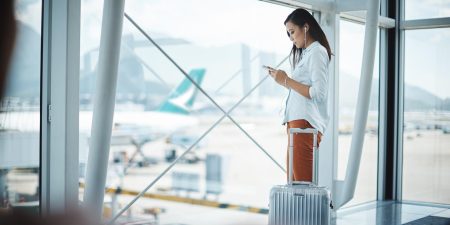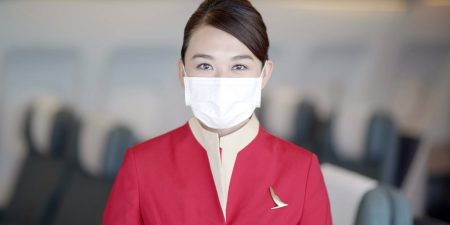Cathay Pacific announces 2017 Interim Results
| Results |
|
1H 2017 |
1H 2016 |
Change |
|
Revenue |
HK$ million |
45,858 |
45,683 |
+0.4% |
|
(Loss)/profit attributable to the shareholders of Cathay Pacific |
HK$ million |
(2,051) |
353 |
-681.0% |
|
(Loss)/earnings per share |
HK cents |
(52.1) |
9.0 |
-678.9% |
|
Dividend per share |
HK$ |
- |
0.05 |
-100.0% |
The Group reported an attributable loss of HK$2,051 million for the first six months of 2017. This compares to an attributable profit of HK$353 million for the same period in 2016 and an attributable loss of HK$928 million in the second six months of 2016. The loss per share for the first six months of 2017 was HK52.1 cents compared to earnings per share of HK9.0 cents for the first six months of the previous year.
Fundamental structural changes within the airline industry continue to affect the operating environment for our airlines and created difficult operating conditions in the first half of 2017. The factors which affected our performance were largely the same as in 2016. Intense competition with other airlines was the most significant. Other major adverse factors were higher fuel prices (including the effect of our hedging), the adverse effect of the strength of the Hong Kong dollar on revenues denominated in other currencies, and higher aircraft maintenance costs.
Our three-year corporate transformation programme has the goal of achieving returns above the cost of capital and of reducing our unit costs, excluding fuel. However, it is about more than just cost savings. We must strengthen our brand while maintaining our high standards, identity and excellence in a challenging environment. The objective is a long term sustainable recovery in revenues and financial performance, in which we compete successfully in an industry that is undergoing fundamental structural changes. Through the transformation, Cathay Pacific is intended to emerge as a leaner, more agile and more profitable airline that responds to changing market trends and customer preferences.
The contribution from subsidiary and associated companies was satisfactory.
Passenger business
The Group’s passenger revenue in the first six months of 2017 was HK$32,105 million, a decrease of 3.9% compared to the same period in 2016. Capacity increased by 1.1%, reflecting the introduction of a route to Tel Aviv and increased frequencies on other routes. The load factor increased by 0.2 percentage points, to 84.7%. Yield fell by 5.2% to HK51.5 cents, reflecting intense competition in all classes and the adverse effect of the strength of the Hong Kong dollar on revenues denominated in other currencies.
Cargo business
Cargo revenue improved, reflecting robust demand. Tonnage carried grew faster than capacity, and yield benefited from the resumption (from April) of fuel surcharges and improving demand for Mainland China exports. Demand for shipments within Asia was stronger and shipments on European routes grew. The Group’s cargo revenue in the first six months of 2017 was HK$10,515 million, an increase of 11.7% compared to the same period in 2016. The cargo capacity of Cathay Pacific and Cathay Dragon increased by 2.3%. The load factor increased by 4.0 percentage points, to 66.2%. Tonnage carried increased by 11.5%. Yield increased by 4.4% to HK$1.66.
Cost
Total fuel costs for Cathay Pacific and Cathay Dragon (before the effect of fuel hedging) increased by HK$2,871 million (or 33.4%) compared with the first half of 2016, reflecting a 31.5% increase in average fuel prices and a 1.6% increase in consumption. Fuel is the Group’s most significant cost, accounting for 30.4% of total operating costs in the first half of 2017 (compared to 29.1% in the same period in 2016). Fuel hedging losses were reduced. After taking them into account, fuel costs increased by HK$1,678 million (or 12.7%) compared with the first half of 2016.
There was a 2.8% increase in non-fuel costs per available tonne kilometre. Excluding fuel and one-off items, the increase was 0.5%. Cost savings offset higher aircraft maintenance, depreciation and finance costs.
Congestion at Hong Kong International Airport and air traffic control constraints in the Greater China region continued to impose costs on the Group. We are doing more to improve the reliability of our operations. This was reflected in a 1.7 percentage points improvement in on-time performance between the first halves of 2016 and 2017.
Exceptional items
Several special factors affected the results in the first half of 2017. In March, the European Commission issued a decision finding that a number of international air cargo carriers, including Cathay Pacific, had agreed to cargo surcharge levels prior to 2007 and that such agreements infringed European competition law and imposed a fine of Euros 57.12 million (equivalent to approximately HK$498 million) on Cathay Pacific. Although an application has been made to the General Court of the European Union to annul the decision which led to the fine, the full amount of the fine has been recognised.
In March, Air China announced the completion of the issue of 1.44 billion A shares. As a result, Cathay Pacific’s shareholding in Air China was diluted from 20.13% to 18.13% and a gain of HK$244 million was recognised on the deemed partial disposal. In April, Cathay Pacific disposed of its entire interest in Travelsky Technology Limited at a profit of HK$586 million. In the first half of 2017, Cathay Pacific commenced a three-year corporate transformation programme intended to address the fundamental challenges that it is facing in the current airline industry environment. In May, as part of this programme, we announced a reorganisation of our head office. The amount of the associated redundancy costs (HK$224 million) has been recognised in staff expenses.
Network
We introduced services to Tel Aviv in March, which have been very well received. We introduced seasonal services to Barcelona (in July) and will introduce seasonal services to Christchurch (in December). To date in 2017, we have increased frequencies to Adelaide, Boston, Hanoi, Ho Chi Minh City, London Gatwick, Manchester, Toronto (between June and August) and Vancouver and will increase frequencies to Madrid, Paris and San Francisco later in the year. We stopped flying to Riyadh in March. In May, Cathay Pacific stopped flying to Kuala Lumpur, with Cathay Dragon operating the four-times-daily service instead. Cathay Dragon’s service to Tokyo Haneda will be suspended from October. Cathay Pacific’s two-times-weekly cargo service to Portland, Oregon will become a three-times-weekly service in September.
Fleet
We took delivery of six Airbus A350-900 aircraft during the first six months of 2017 and another one in July. We now have 17 Airbus A350-900s in our fleet and expect to take delivery of a further five aircraft of this type during the remainder of 2017. We retired our final four Airbus A340-300 aircraft in the first half of the year. We retired one Boeing 747-400BCF converted freighter aircraft in June and wet-leased two Boeing 747-8F freighters from Atlas Air Worldwide in the same month.
Product
The Airbus A350 aircraft have lower operating costs than existing aircraft and have been well received by customers. The aircraft have our latest cabins, seats and entertainment systems and inflight connectivity for passengers’ mobile devices. The G16 lounge at Hong Kong International Airport is undergoing extensive refurbishment. The opening date of the refurbished lounge will be announced in due course. In the fourth quarter of 2017, we will open a new lounge at Changi Airport in Singapore.
Prospects
Cathay Pacific Chairman John Slosar said: “We do not expect the operating environment in the second half of 2017 to improve materially. In particular, the passenger business will continue to be affected by strong competition from other airlines and our results are expected to be adversely affected by higher fuel prices and our fuel hedging positions. However, the outlook for the cargo business is good and we expect robust demand and growth in cargo capacity, yield and load factor in the second half of this year. We expect to see the benefits of our transformation in the second half of 2017, and the effects will accelerate in 2018.
“We are addressing the industry challenges through our corporate transformation and by expanding our route network, increasing frequencies on our most popular routes and buying more fuel-efficient aircraft. This will help us to increase productivity and to reduce costs while improving the quality of our services to customers. We continue to enhance our high standards of customer service and are proud of the quality, dedication and professionalism of our staff.
“The new management team is acting decisively to make Cathay Pacific and Cathay Dragon better airlines and stronger businesses, delivering more to customers with improved productivity. We are confident that we are on the right track to achieve strong and sustainable long-term performance, with a leaner, more competitive business, while enhancing the brand and the quality of services that our customers deserve and expect. These services are always delivered by our people, who remain dedicated in these volatile times. I would like to thank them for their hard work and commitment.
“Our commitment to Hong Kong and its people remains unwavering and we will continue to make strategic investments to develop and strengthen Hong Kong’s position as Asia’s largest international aviation hub.”










